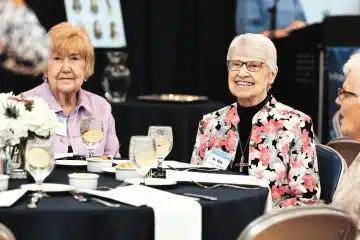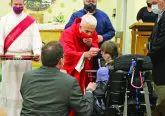St. Rita School for the Deaf celebrates 100th anniversary

By Patricia McGeever
The Catholic Telegraph
One hundred years ago, a young priest in the Archdiocese of Cincinnati was given a special assignment. Archbishop Henry Moeller instructed Father Henry Waldhaus to build a school to educate deaf children.
This was a challenge on so many levels. But a century later, the mission he accomplished continues to thrive as St. Rita School for the Deaf.
The school’s property and the programs have changed over time but the goal remains the same: to prepare students to be productive members of society by teaching communication for life.
“To be a quality program you have to be flexible to the needs of the time,” said Executive Director Gregory Ernst. “So, I think in 1915, they began to address the needs of a child who was deaf who wanted Catholic education.”
Now, it is so much more.
St. Rita was established on 237 acres the archdiocese bought after many fundraising efforts. It would start selling off the land in the 1930’s to Wright Aeronautical Company that would later become General Electric. Prior to that, though, local farmers helped farm the land. A frame building on site was lost in a fire but the brick building that was there in 1915, and was once the boys’ dorm, still stands. It’s now used for the school’s annual Haunted House fundraiser. Eleven children enrolled in the school when it opened.
“In the beginning, everybody had to be residential,” said Ernst. “Everybody had to live here so you had them in that total environment.”
The students were taught by three Sisters of Charity. Today, there are 180 children from preschool to the 12th grade. Only 11 live on campus, including 10th grader Cydni Estes who moved here when she was in third grade. She says the best thing about the school is the teachers because they help students “by working with us one by one.”
Some teachers, like Nicole Cherry, are deaf.
“Most of the time when deaf kids arrive here there is no language and they’re kind of stuck,” Cherry said through Staff ALS Interpreter Lacey Perkins. “Their communication is not there. Their behavior starts to blow up and they start to get frustrated. So we teach and teach the language and give them language as much as possible.”
There are six children in Cherry’s class this year and that’s considered large by St. Rita’s standards.
St. Rita is no longer considered just a school for deaf children. Now it also serves those who are hearing impaired and have other communication disorders. It is a leader in teaching children with Apraxia, a neurological disorder through which a child can’t properly process what they hear. There are 60 children attending St. Rita who’ve been diagnosed with Childhood Apraxia of Speech. These children learn best when information is given orally and visually through sign language. Fine motor skills are also affected. Fifteen years ago no one knew much about Apraxia. The staff found a great resource in a doctor at Cincinnati Children’s Hospital Medical Center and were able to develop a curriculum.
“Now when the community looks for Apraxia training they look to us as experts on Apraxia but there was a time when we were out looking for other experts to teach us,” said Rebecca Hardesty, director of student services.
Another change came during the 1990s, when St. Rita started the LOFT program. This opened the doors to hearing children. Language Opportunities for Tots is designed to meet developmental needs of children from the time they’re born until they turn five.
“We termed it reverse mainstreaming. Since we’re geared for the special needs child, we accepted the hearing child into our program,” said Hardesty.
It grew out of a teacher’s master’s thesis. It blends traditional teaching methods with technology, and that is yet another way St. Rita has evolved. Much of the teaching material can be accessed online.
“I don’t have to go out and buy 44 books,” said Ernst. “I can go out and get the information off the internet so it saves some money.”
St. Rita depends on generous donors to help fund its special programs and almost all of the children who attend need financial assistance. St. Rita has never turned away a child because of a family’s inability to pay.
In its century of serving, St. Rita School for the Deaf has opened a world of possibilities to its students. The social training for children is as important as their schoolwork. St. Rita is celebrating its success all year long. The school kicked off its centennial with a special Mass in January. On Oct. 17, it will bury a time capsule filled with important items from the past 10 decades. The mission begun when Father Waldhaus was given a seemingly impossible task was guided for 100 years by faith. And it’s no coincidence that it was named for St. Rita, the saint of impossible causes.
This story originally appeared in the May 2015 print edition of The Catholic Telegraph.













